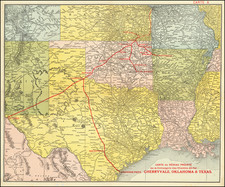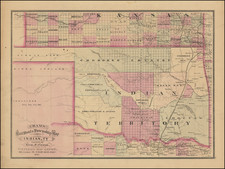Striking map of the Cherokee Nation lands in Indian Territory, showing the allotment of lands between January 1, 1903 and June 30, 1903.
The map illustrates an important period in the history of the Cherokee Nation and the broader Native American experience, particularly concerning the United States government's policy of allotment. The allotment process depicted in the map was part of a larger federal policy known as the Dawes Act of 1887, which aimed to assimilate Indigenous peoples into American society by dissolving their communal land holdings and allocating parcels to individual households. The intention was to encourage farming and private land ownership, which was in line with European-American values of the time, but it often resulted in significant loss of tribal land and culture, and allowed predatory land acquisition practices by speculators.
The map is a detailed cartographic representation of the Cherokee Nation lands within the Indian Territory, showing the state of land allotment within the six-month period of 1903. . The map also includes the locations of towns, roads, rivers, and other pertinent features, which would have been important for both the administration of the allotment process and for the Cherokee people navigating the changes to their land.
The allotment process led to a checkerboard pattern of land ownership, which is visually apparent on the map, with parcels designated to individual Native American families, and other parcels opened up to non-Native settlement. The distribution of land during this period was often inequitable and marred by corruption. The end result was a profound transformation of the Cherokee Nation, with far-reaching effects on its social, economic, and political structures.
The period was a time of significant transition and turmoil for the Cherokee Nation due to the implementation of allotment policies by the United States government. The historical context of this period is marked by the Curtis Act of 1898, which effectively dissolved the tribal governments and extended the Dawes Act to the "Five Civilized Tribes" including the Cherokees. This act mandated the survey and allotment of tribal lands in the Indian Territory, which is present-day Oklahoma.
During this time, the United States government increased its pressure on the Cherokee and other tribes to cede their land rights and sovereignty. The government's aim was to prepare the Indian Territory for statehood, which would come to fruition in 1907 with the establishment of Oklahoma. For the Cherokee people, this period led to the loss of millions of acres of their ancestral lands.
The consequences of these policies were profound. By the end of the allotment process, much of the land that had been held in common by the Cherokee Nation was in the hands of non-Native Americans. Many Cherokees were left with allotments that were too small to be economically viable or were taken advantage of by unscrupulous land buyers. This period also saw the erosion of Cherokee self-governance and the imposition of federal and eventually state laws over their affairs.










![[ Colorado ] [ Indian Territory on verso ]](https://storage.googleapis.com/raremaps/img/small/101102.jpg)

![[ Oil in the Oklahoma Panhandle ] Map of Cimarron County Oklahoma](https://storage.googleapis.com/raremaps/img/small/102584.jpg)

![Map of the Missouri Pacific and St. Louis, Iron Mountain and Southern Railway and Connections [Missouri Pacific Railway. St. Louis & All Points East Chair Cars Free Fast Mail Route]](https://storage.googleapis.com/raremaps/img/small/91606.jpg)